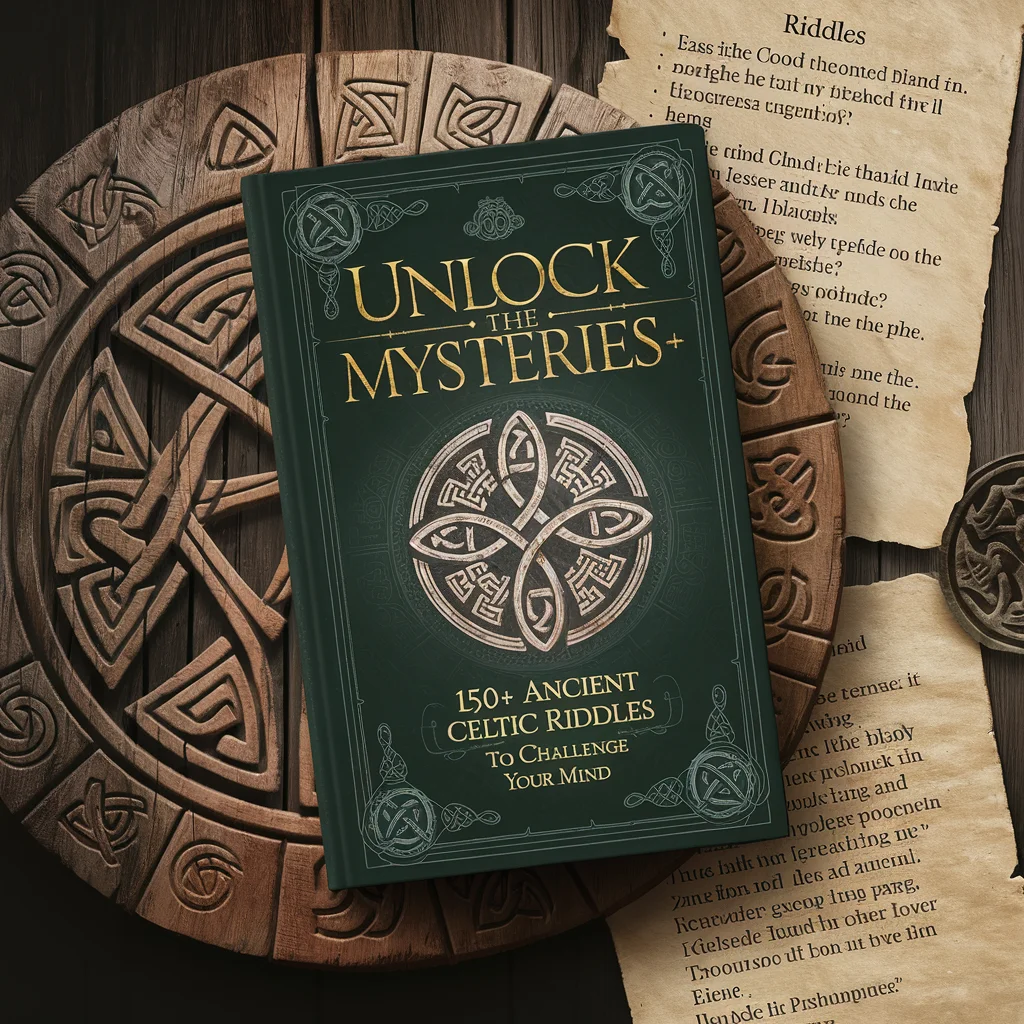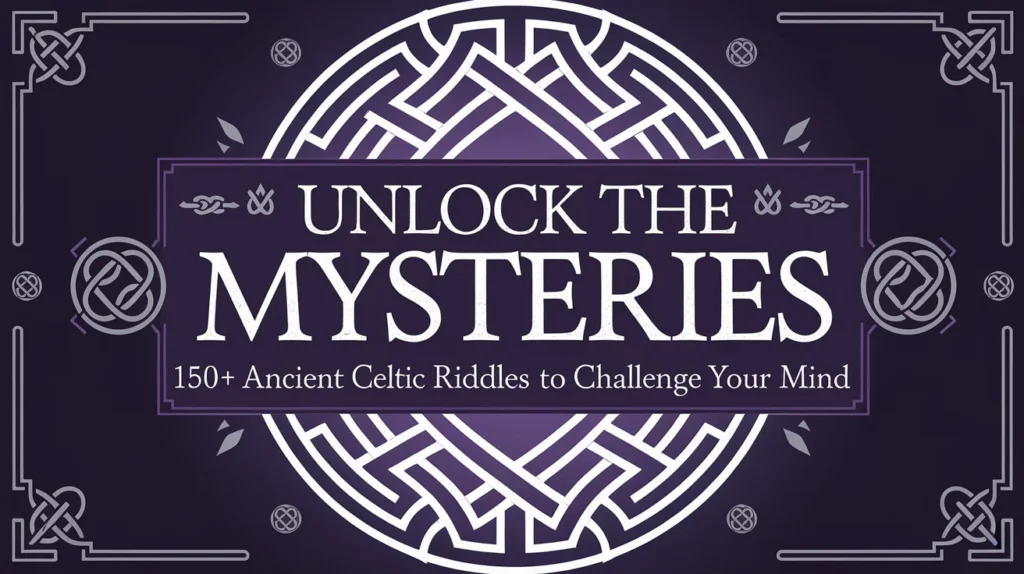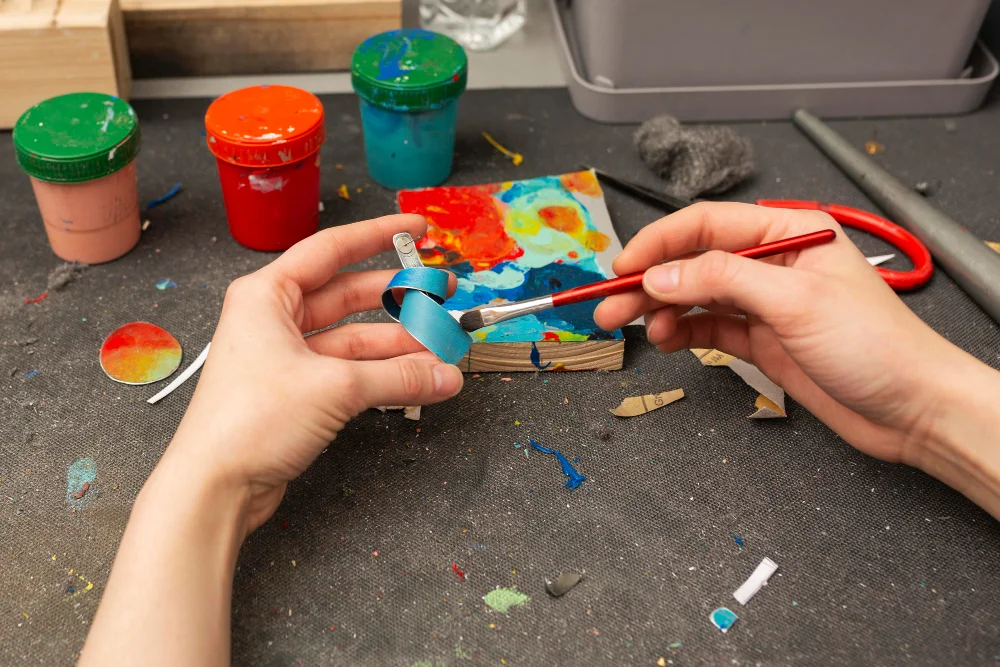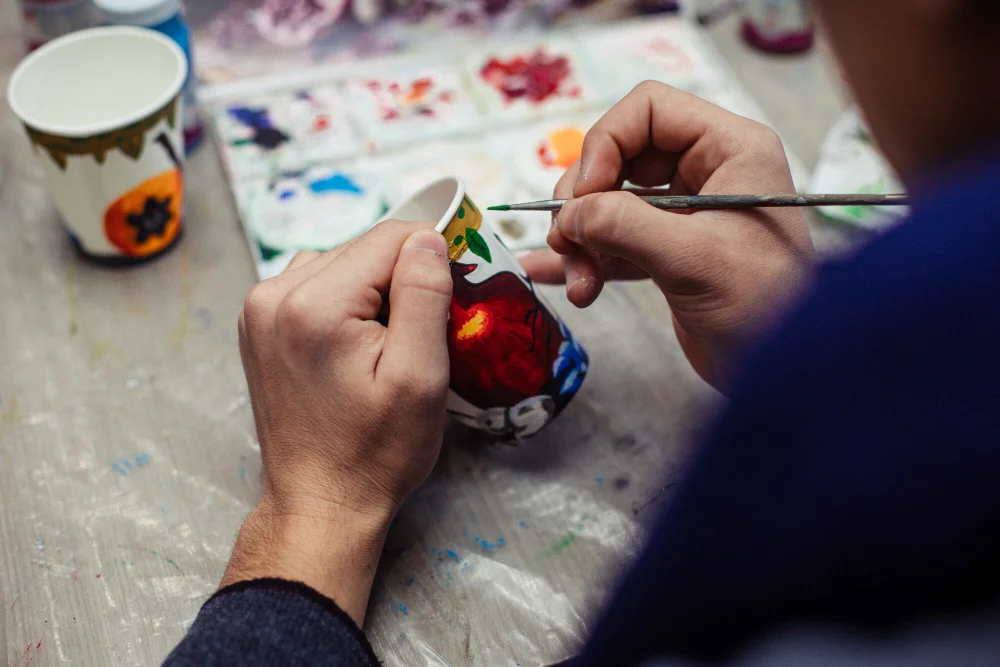Celtic culture, rich in history and steeped in mysticism, has gifted us many traditions—one of the most fascinating being their riddles. These riddles, passed down through generations, not only entertained but also carried deeper meanings, often related to the natural world, spirituality, and the mysteries of life itself. In this article, we’ll explore the world of ancient Celtic riddles, uncovering their origins, significance, and offering a collection of over 150 mind-bending riddles for you to solve. Ready to dive in and challenge your intellect? Let’s go!
Nature and Animals: Celtic Riddles
I have branches, but no fruit, trunk, or leaves. What am I?
Answer: A bank.
I can be cracked, I can be made, I can be told, I can be played. What am I?
Answer: A joke.
What flies without wings, can’t be seen, and can make no sound?
Answer: Time.
The more you take, the more you leave behind. What am I?
Answer: Footsteps.
I have a head, but never a body, and I am always at the end of a story. What am I?
Answer: A tale or story.
I am always hungry; I must always be fed. The finger I touch, will soon turn red. What am I?
Answer: Fire.
I have no legs, but I can run; I have no lungs, but I can breathe. What am I?
Answer: Water.
What has roots as nobody sees, Is taller than trees, Up, up it goes, And yet never grows?
Answer: A mountain.
What has an eye but cannot see?
Answer: A needle.
I am not alive, but I grow; I do not have lungs, but I breathe; I do not have eyes, but you can see me. What am I?
Answer: A flame.
What is always coming but never arrives?
Answer: Tomorrow.
I have a heart that doesn’t beat, a mouth that doesn’t speak, and a body that doesn’t move. What am I?
Answer: An artichoke.
What can travel around the world while staying in the corner?
Answer: A stamp.
What can you catch but never throw?
Answer: A cold.
I am tall when I am young, and I am short when I am old. What am I?
Answer: A candle.
What runs but never walks, has a bed but never sleeps, and can’t be seen but can be felt?
Answer: A river.
What gets wetter the more it dries?
Answer: A towel.
What is full of holes but still holds a lot of weight?
Answer: A net.
I am invisible, but you can feel me. I am not alive, but I can move things. What am I?
Answer: Wind.
What has keys but can’t open locks?
Answer: A piano.
Ancient Celtic Riddles for Adults: Mind-Bending Challenges
I have no legs, but I can run; I have no lungs, but I can breathe. What am I?
Answer: Water.
What comes once in a minute, twice in a moment, but never in a thousand years?
Answer: The letter “M”.
I have a heart that doesn’t beat, a mouth that doesn’t speak, and a body that doesn’t move. What am I?
Answer: An artichoke.
What can be cracked, made, told, and played?
Answer: A joke.
What can travel around the world while staying in the corner?
Answer: A stamp.
What is always coming but never arrives?
Answer: Tomorrow.
I am always hungry; I must always be fed. The finger I touch, will soon turn red. What am I?
Answer: Fire.
The more you take, the more you leave behind. What am I?
Answer: Footsteps.
I can be cracked, I can be made, I can be told, I can be played. What am I?
Answer: A joke.
What can you catch but never throw?
Answer: A cold.
What is tall when young but short when old?
Answer: A candle.
What has keys but can’t open locks?
Answer: A piano.
What gets wetter the more it dries?
Answer: A towel.
What has an eye but cannot see?
Answer: A needle.
What can go up a chimney down, but can’t go down a chimney up?
Answer: An umbrella.
What has a head, a tail, but no body?
Answer: A coin.
What comes once in a minute, twice in a moment, but never in a thousand years?
Answer: The letter “M”.
What flies without wings, can’t be seen, and can make no sound?
Answer: Time.
What has roots as nobody sees, Is taller than trees, Up, up it goes, And yet never grows?
Answer: A mountain.
What begins with T, ends with T, and has T in it?
Answer: A teapot.
Famous Ancient Celtic Riddles: Mystical Challenges

What has roots as nobody sees, Is taller than trees, Up, up it goes, And yet never grows?
Answer: A mountain.
What flies without wings, can’t be seen, and can make no sound?
Answer: Time.
I have a head, but never a body, and I am always at the end of a story. What am I?
Answer: A tale or story.
I am always hungry; I must always be fed. The finger I touch, will soon turn red. What am I?
Answer: Fire.
What is always coming but never arrives?
Answer: Tomorrow.
I can be cracked, I can be made, I can be told, I can be played. What am I?
Answer: A joke.
What has keys but can’t open locks?
Answer: A piano.
What gets wetter the more it dries?
Answer: A towel.
What runs but never walks, has a bed but never sleeps, and can’t be seen but can be felt?
Answer: A river.
What can you catch but never throw?
Answer: A cold.
I have no legs, but I can run; I have no lungs, but I can breathe. What am I?
Answer: Water.
What has an eye but cannot see?
Answer: A needle.
What can go up a chimney down, but can’t go down a chimney up?
Answer: An umbrella.
The more you take, the more you leave behind. What am I?
Answer: Footsteps.
I am invisible, but you can feel me. I am not alive, but I can move things. What am I?
Answer: Wind.
What has a heart but doesn’t beat, a mouth but doesn’t speak, and a body but doesn’t move?
Answer: An artichoke.
What is full of holes but still holds a lot of weight?
Answer: A net.
I have a tail but never a head. What am I?
Answer: A coin.
I am tall when I am young, and I am short when I am old. What am I?
Answer: A candle.
I am not alive, but I can grow. I do not have lungs, but I can breathe. What am I?
Answer: A flame.
Nature and Animals: Celtic Riddles
What is full of holes but still holds a lot of weight?
Answer: A net.
What is always moving but never travels?
Answer: A clock.
What has many keys but can’t open a single door?
Answer: A piano.
What gets bigger the more you take away from it?
Answer: A hole.
What has one eye but cannot see?
Answer: A needle.
What has a tongue but cannot speak?
Answer: A shoe.
What begins with T, ends with T, and has T in it?
Answer: A teapot.
I go all around the world but always stay in the corner. What am I?
Answer: A stamp.
What can be broken but never held?
Answer: A promise.
What has legs but doesn’t walk?
Answer: A table.
What can run but never walks, has a bed but never sleeps?
Answer: A river.
What can you hold in your right hand but not in your left?
Answer: Your left hand.
What is so fragile that saying its name breaks it?
Answer: Silence.
What has teeth but never bites?
Answer: A comb.
What can travel through water without getting wet?
Answer: A reflection.
What has an end but no beginning?
Answer: A circle.
What gets wetter the more it dries?
Answer: A towel.
What comes down but never goes up?
Answer: Rain.
What can be seen but not touched?
Answer: A shadow.
What is invisible but can be seen in the light and never at night?
Answer: A shadow.
Ancient Celtic Riddles for Adults
I am the king of the road but never move. What am I?
Answer: A road sign.
What is always in front of you but can’t be seen?
Answer: The future.
What can you catch but not throw?
Answer: A cold.
What goes up but never comes down?
Answer: Your age.
What has a neck but no head?
Answer: A bottle.
What has keys but can’t open locks?
Answer: A piano.
What has a foot but no legs?
Answer: A ruler.
What has an eye but can’t see?
Answer: A needle.
What is always running but never gets tired?
Answer: A refrigerator.
What has a ring but no finger?
Answer: A phone.
What comes down but never goes up?
Answer: Rain.
What is a room with no doors or windows?
Answer: A mushroom.
What has a face but no eyes?
Answer: A clock.
What is harder to catch the faster you run?
Answer: Your breath.
What is something you can hear but not see?
Answer: A sound.
What can be filled but never be emptied?
Answer: A net.
What can be made but never seen?
Answer: A wish.
What can you not see but can feel?
Answer: The wind.
What begins with an “E,” ends with an “E,” and has a single letter in it?
Answer: An envelope.
What has a tail but no body?
Answer: A coin.
Famous Ancient Celtic Riddles
What has many keys but can’t open a door?
Answer: A piano.
What has no legs, but can run, has no lungs but can breathe?
Answer: Water.
What comes once in a minute, twice in a moment, but never in a thousand years?
Answer: The letter “M.”
What can be cracked, made, told, and played?
Answer: A joke.
What has a head, a tail, but no body?
Answer: A coin.
What gets wetter the more it dries?
Answer: A towel.
What is so light that a feather can’t compare, yet a million men can’t lift it?
Answer: A breath.
What is always in front of you but can’t be seen?
Answer: The future.
What begins with T, ends with T, and has T in it?
Answer: A teapot.
What has an eye but can’t see?
Answer: A needle.
What gets bigger the more you take away?
Answer: A hole.
What has keys but can’t open locks?
Answer: A piano.
What has a neck but no head?
Answer: A bottle.
What comes down but never goes up?
Answer: Rain.
What is invisible but can be felt?
Answer: The wind.
What has a tongue but cannot speak?
Answer: A shoe.
What flies without wings, can’t be seen, and can make no sound?
Answer: Time.
What has teeth but never bites?
Answer: A comb.
What can be cracked but never bent?
Answer: A promise.
What begins and has no end, always moves but never stays the same?
Answer: The river.
Nature and Animals: Celtic Riddles
What can you see but never touch?
Answer: The sun.
What is white when it’s dirty and black when it’s clean?
Answer: A blackboard.
What flies without wings, can’t be seen, and can’t be touched?
Answer: Time.
What can fill a room but takes up no space?
Answer: Light.
I can be cracked, made, told, and played. What am I?
Answer: A joke.
What comes up but never goes down?
Answer: Your age.
What runs but never walks, has a bed but never sleeps?
Answer: A river.
What is always in front of you but can’t be seen?
Answer: The future.
What can you hold without using your hands?
Answer: Your breath.
What has no beginning or end, only moves in circles?
Answer: A wheel.
What can you catch but never throw?
Answer: A cold.
What’s invisible but still powerful enough to change the world?
Answer: Love.
What has no eyes but can still see?
Answer: A needle.
What is always moving but never leaves its spot?
Answer: The clock’s hands.
What has hands but can’t clap?
Answer: A clock.
What begins with “P” and ends with “E” and has a million letters in it?
Answer: The post office.
What can be long or short, can be grown or bought, can be painted or left bare, can be round or square?
Answer: A box.
What is the key to the door of freedom but only works when you let go?
Answer: Forgiveness.
What can be cracked, cracked, but never broken?
Answer: A secret.
What is always running but never tired?
Answer: The water in a river.
Ancient Celtic Riddles for Adults
I have a heart that doesn’t beat. What am I?
Answer: An artichoke.
What is yours, but others use it more than you?
Answer: Your name.
What has a bottom at the top and a top at the bottom?
Answer: A leg.
What is hard to find but easy to lose?
Answer: A penny.
What can be touched but never held?
Answer: A feeling.
What is tall when it’s young but short when it’s old?
Answer: A candle.
What belongs to you but other people use it more than you do?
Answer: Your name.
What gets wetter the more it dries?
Answer: A towel.
What happens once in a year, twice in a week, but never in a day?
Answer: The letter “E.”
What has keys but can’t open locks?
Answer: A piano.
What can be caught but never thrown?
Answer: A cold.
What is bigger when it’s upside down?
Answer: The number six.
What has a face but no eyes, mouth, or nose?
Answer: A clock.
What is never seen but always felt?
Answer: A breeze.
What can be heard but not seen?
Answer: Sound.
What has many faces but can’t smile?
Answer: A die.
What starts with an “E,” ends with an “E,” and has one letter in it?
Answer: An envelope.
What has legs but doesn’t walk?
Answer: A table.
What begins with T, ends with T, and has T in it?
Answer: A teapot.
What is invisible but can be felt, can’t be seen, but always leaves a trace?
Answer: Wind.
Famous Ancient Celtic Riddles
What can’t be touched but is always felt?
Answer: Emotion.
What is full of holes but still holds a lot of weight?
Answer: A net.
What comes but never goes?
Answer: Tomorrow.
What has a neck but no head?
Answer: A bottle.
What can go up but never comes down?
Answer: Your age.
What has a ring but no finger?
Answer: A phone.
What has keys but can’t open locks?
Answer: A piano.
What starts with an “E” but only has one letter in it?
Answer: An envelope.
What can’t speak but can still say something?
Answer: A gesture.
What has a tongue but cannot speak?
Answer: A shoe.
What gets more valuable the more you give away?
Answer: Love.
What is so fragile that just saying its name breaks it?
Answer: Silence.
What has teeth but cannot bite?
Answer: A comb.
What has a bed but never sleeps?
Answer: A river.
What has hands but can’t clap?
Answer: A clock.
What is light as a feather, yet the strongest man can’t hold it for much longer?
Answer: Your breath.
What can be broken but not held?
Answer: A promise.
What can be made but never seen?
Answer: A wish.
What starts with T, ends with T, and has T in it?
Answer: A teapot.
What is something you can touch but not see?
Answer: A thought.
Nature and Animals: Celtic Riddles
What flies without wings, can travel great distances, yet never leaves the ground?
Answer: A kite.
What has a face, but no eyes, and can tell the time?
Answer: A clock.
I’m alive without breath, and cold as death; I’m never thirsty, but always drinking. What am I?
Answer: A fish.
What is as light as a feather, but even the world’s strongest man can’t hold it for long?
Answer: Your breath.
What can’t be seen, can’t be touched, but can be felt?
Answer: A feeling.
I grow without roots, live without lungs, and can fall but never touch the ground. What am I?
Answer: A shadow.
What has a bed but never sleeps?
Answer: A river.
What runs but never walks?
Answer: Water.
What has a horn but does not blow it?
Answer: A rhinoceros.
What is tall when it is young, but short when it is old?
Answer: A candle.
What has keys but can’t open doors?
Answer: A piano.
What can carry a heavy load, but is never seen moving?
Answer: The wind.
What can be broken, but never touched?
Answer: A promise.
What has a mouth but doesn’t speak?
Answer: A river.
What has legs but doesn’t walk?
Answer: A table.
What comes down but never goes up?
Answer: Rain.
What grows but never decays?
Answer: Knowledge.
What has hands but can’t clap?
Answer: A clock.
What can be heavy, but is also light?
Answer: A feather.
What is in the middle of water, yet can never be wet?
Answer: The letter ‘T.’
Ancient Celtic Riddles for Adults
What has a bed but never sleeps, and runs but never walks?
Answer: A river.
What flies without wings, yet never moves from its place?
Answer: Time.
What can’t be touched but can always be felt?
Answer: Emotions.
What is full of holes but still holds weight?
Answer: A net.
What has a neck but no head?
Answer: A bottle.
What is full of knowledge but never speaks?
Answer: A book.
What has a tongue but never speaks, and can carry loads but never walks?
Answer: A shoe.
What has keys but can’t open locks?
Answer: A piano.
What has a face but no eyes?
Answer: A clock.
What has a heart but doesn’t beat?
Answer: An artichoke.
What comes once in a year, twice in a week, but never in a day?
Answer: The letter “E.”
What is easy to give, but difficult to take?
Answer: Advice.
What is seen in the middle of March, but not in April?
Answer: The letter “R.”
What has a crown but no throne?
Answer: A tooth.
What runs but never walks, has a bed but never sleeps?
Answer: A river.
What is the beginning of eternity, the end of time, and the beginning of every end?
Answer: The letter “E.”
What has a heart that doesn’t beat?
Answer: An artichoke.
What has no eyes, yet it can still see?
Answer: A needle.
What is always running, yet never moves?
Answer: Water.
What can be cracked, made, told, and played?
Answer: A joke.
Famous Ancient Celtic Riddles
What has a face but no eyes, and can tell time?
Answer: A clock.
What has keys but can’t open locks?
Answer: A piano.
What is as light as a feather, but even the world’s strongest man can’t hold it for long?
Answer: Your breath.
What runs but never walks, has a bed but never sleeps?
Answer: A river.
What has hands but can’t clap?
Answer: A clock.
What is tall when young, but short when old?
Answer: A candle.
What gets wetter the more it dries?
Answer: A towel.
What can be broken but not touched?
Answer: A promise.
What can be heard but not seen?
Answer: Sound.
What is invisible but can be felt?
Answer: The wind.
What has a mouth but cannot speak?
Answer: A river.
What has a neck but no head?
Answer: A bottle.
What is always in front of you but can’t be seen?
Answer: The future.
What has many faces but can’t smile?
Answer: A die.
What is invisible but can still change the world?
Answer: Love.
What has a crown but no throne?
Answer: A tooth.
What can be heard but never seen?
Answer: A thought.
What has no eyes but can still see?
Answer: A needle.
What is light as a feather, yet even the strongest man can’t hold it for long?
Answer: Your breath.
What belongs to you but others use it more than you?
Answer: Your name.
Conclusion
Celtic riddles are much more than just fun puzzles—they are a gateway into the rich cultural and intellectual traditions of the ancient Celts. Through these riddles, you can see the ingenuity and creativity that defined Celtic thought. From mysterious and cryptic questions about nature and the world to light-hearted and humorous puzzles, these riddles serve as a reflection of how the Celts used storytelling and wordplay to entertain, teach, and challenge one another.
These ancient riddles are an enjoyable and educational way to connect with Celtic heritage while testing your wit and imagination. Whether you’re engaging in a casual conversation with friends or looking to dive deep into the fascinating world of Celtic culture, these riddles provide endless opportunities for entertainment and learning.
By solving Celtic riddles, you not only get to experience the ancient world of the Celts but also enhance your cognitive abilities, improve your problem-solving skills, and connect with an age-old tradition of playful, thoughtful challenges. So, next time you’re looking for a mental workout or a fun activity to share with friends or family, consider diving into these ancient Celtic riddles!
Frequently Asked Questions
- What are Celtic riddles?
Celtic riddles are puzzles or questions that come from the ancient Celtic traditions. They often feature wordplay, mystery, and cleverness, and were used for both entertainment and teaching in Celtic societies. These riddles cover a variety of topics, including nature, animals, and abstract concepts, reflecting the Celtic people’s deep connection with the world around them. - Are Celtic riddles still used today?
Yes, Celtic riddles are still enjoyed today as part of cultural celebrations, festivals, and educational activities. Many people enjoy solving them as a way to connect with ancient traditions or simply as a fun challenge. Some modern-day competitions even include Celtic riddles. - How do Celtic riddles compare to other types of riddles?
Celtic riddles are known for their use of metaphor, symbolism, and nature-related imagery. While many riddles from other cultures might focus on logical reasoning or common knowledge, Celtic riddles often require creative thinking and a deeper connection with the natural world. - What is the cultural significance of Celtic riddles?
Celtic riddles are an integral part of Celtic mythology and culture. They reflect the Celts’ appreciation for language, cleverness, and connection to nature. Riddles were a way to pass down knowledge, entertain, and challenge individuals to think critically. They also served as a means of communication, often used in festivals and gatherings. - Where can I find more Celtic riddles?
There are many online resources, books, and Celtic heritage websites where you can find more Celtic riddles. Some great places to start include Celtic folklore collections, puzzle books, and websites dedicated to ancient Celtic traditions. You can also try reaching out to local Celtic heritage groups or visiting Celtic-themed events for more riddles and cultural activities. - Are Celtic riddles appropriate for children?
Yes! Many Celtic riddles are fun and easy to solve, making them great for children. They can also serve as a learning tool to help develop problem-solving skills and creativity. Just be sure to choose riddles that are suitable for the child’s age and understanding level. - Can solving Celtic riddles improve my cognitive skills?
Absolutely! Solving riddles requires critical thinking, pattern recognition, and creativity—all of which are great for your brain. By regularly engaging with riddles, you can sharpen your cognitive abilities, improve problem-solving skills, and develop a stronger ability to think outside the box. - Why do some Celtic riddles seem so difficult?
Celtic riddles can be tricky because they often rely on metaphorical language, cultural references, and wordplay. They are designed to challenge the solver to think in a creative way rather than simply recall facts. Some riddles may require knowledge of Celtic mythology, nature, or language to fully appreciate.






